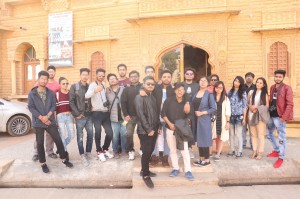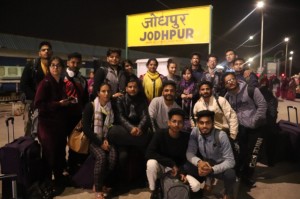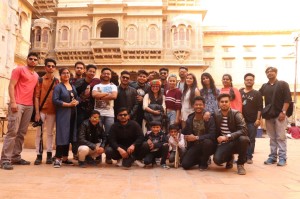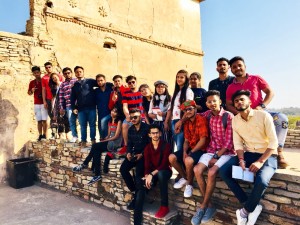Educational Tour to Rajasthan
Introduction
Rajasthan – the Land of ‘Rajputs’ is a very important site as far as the architecture of our country is concerned. Rajputana, as it was once known, marked the presence of Kings and their heirs in the western arid part of the country. The people and the climate of this region resulted in the development of a unique architectural style which became an inspiration for the generations to come.
Large forts and magnificent palaces are the trademarks of the architecture found here and the vernacular yet grand scale is its identity. Thus, an educational tour to Rajasthan was organized in the month of January (2018) for the students of Fourth Semester, MMSOA, so that they could have some practical insights of the vast heritage that stands tall amidst the golden desert land.
Jodhpur – Two Days
The tour started off in the ‘Blue City’. Spread around the magnificent Mehrangarh Fort, the old parts of the city still possess some shades of blue contrasting to the stone-masonry Fort. One of the major architectural marvels is the Umaid Bhawan Palace, which is partially open for public. The students visited and acknowledged the grandeur and intricate details of the Palace. Followed by which the next stop was a short visit to Jaswant Thada. A sacred place where the cremations used to take place, presently marked by Chhatris and beautiful landscapes. Next stop was the Mehrangarh Fort itself. Located on the hilltop, the huge tower-like structural walls showcase the minutely carved elements of the Rajputana architecture – Jali and Jharokha.
A photo-walk was conducted early in the morning to witness the city at its best – with the Fort shining brightly in the rising sun’s light and the blue-white city below embracing the morning calmly. The small yet efficient streets and the organic planning of marketplaces is another important design aspect of the city which could teach a hundred things.
Jaisalmer – Two Days
The golden city – named after the extensively used building material – Yellow Sandstone – is apt to its name. The city washed in sepia-toned yellow is a good example of ‘identity of a city’. With all the residences, shops, etc almost covered in the same pattern and material. Known for the entrances and ant-hill shaped Jaisalmer Fort, the city defines the real character of the desert in its architecture as well.
The Fort complex of Jaisalmer – a city in itself – emerged as a brilliant case study for students as managed to cover the important spaces by foot noticing each and every detail, whether of a Palace or an Old Jain Temple. The walk commenced at the Patwon ki Haveli – a magnificent ensemble of intricate Jalis and Jharokhas.
After the intense architectural dose, the students had a refreshing time in Sam Desert where they were a part of a cultural program trying to understand the roots of the place better.
Udaipur and Chittorgarh
The tour moved ahead to the ‘marble city’. While heading to the city one could notice the never-ending marble traders’ market marking the abundance of this building material. Soon its application could be seen as well in The City Palace. Built with masonry and marble, the palace is another remarkable example of vernacular architecture with climatic solutions like hanging gardens and leveled courtyards applied at the best. Use of international arts and crafts was apparent as well showcasing the worldwide connections of that time. For the first time, students witnessed the transition in building materials. A part of the palace is still undergoing some advanced changes. An evening light and sound show tells the history of Mewar and is a beautiful example of how architecture can be used as a stage to showcase cultural history.
Moving on to Chittorgarh – the happening ground for all the major events in the history of Mewars. A guided tour was conducted for the students to cover the huge 700 acres of Chittorgarh Fort. Visiting the Victory Tower, Rani Padmini Palace, King’s Palace, Kirti Stambh, etc the students got a chance to relate to the history which they usually read only in books.
Jaipur – Two Days
One of the most important of all – the Pink City – named for the extensive use of sandstone is going through a major transformation in terms of technology and growth. The students started their tour in the city with the most important and detailed monument – Jantar Mantar – by Understanding the functionality of huge architectural marvels. Followed by the visit to the City Palace and Hawa Mahal, the students realized the importance of human scale and proportions while studying the delicate details of the jalis and entrance gateways.
The tour to the pink city would have been incomplete without visiting Jawahar Kala Kendra. The students were lucky enough to also witness the exhibition ‘When is Space?’, which helped them understand the details of our profession in a better way.
Towards the end of the tour, the students visited the Amber Fort and Jaigarh Fort – two vast structures defining the concept of scale and proportion at their best. Remarkable paintwork and intricate craftsmanship of these forts make them stand out.
With such extensive study of these places, the students managed to bag various important elemental details and concepts of vernacular and regional architecture. More than anything else they managed to witness and interact with the architectural spaces practically, which is an integral part of architectural education.
   
|